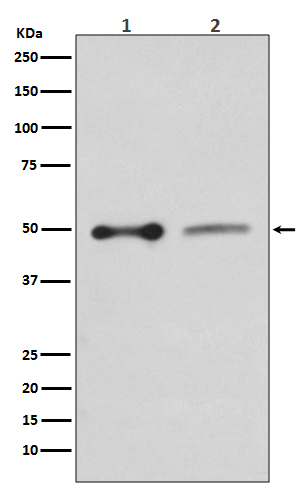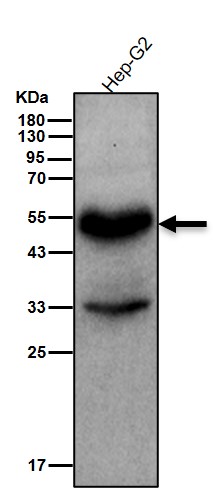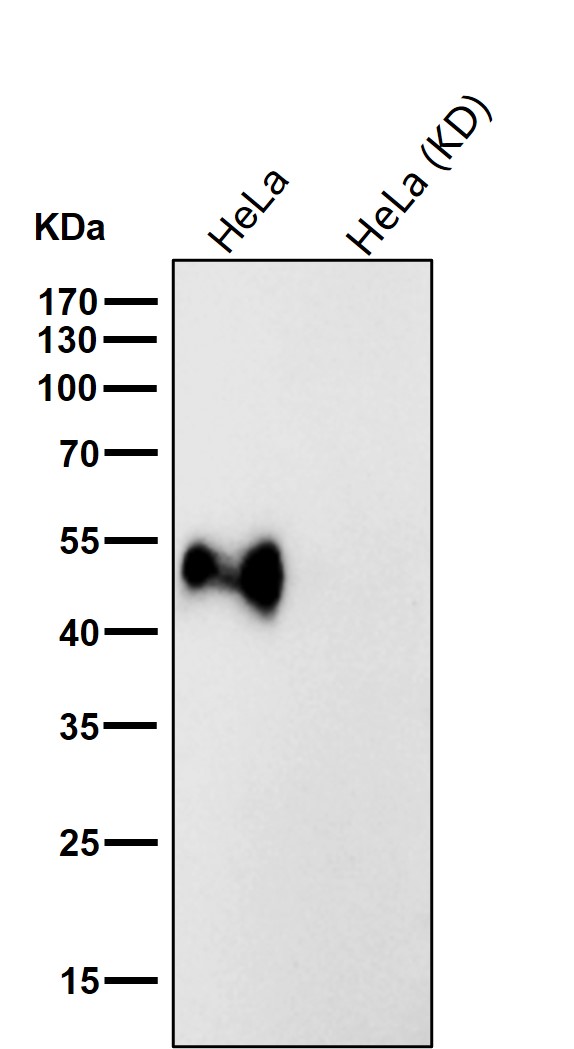


| WB | 咨询技术 | Human,Mouse,Rat |
| IF | 咨询技术 | Human,Mouse,Rat |
| IHC | 1/100-1/200 | Human,Mouse,Rat |
| ICC | 技术咨询 | Human,Mouse,Rat |
| FCM | 咨询技术 | Human,Mouse,Rat |
| Elisa | 咨询技术 | Human,Mouse,Rat |
| Aliases | SLC9A3R1; EBP50; NPHLOP2; NHERF; NHERF-1; NHERF1;;NHERF 1 |
| WB Predicted band size | Calculated MW: 39 kDa ; Observed MW: 50 kDa |
| Host/Isotype | Rabbit IgG |
| Antibody Type | Primary antibody |
| Storage | Store at 4°C short term. Aliquot and store at -20°C long term. Avoid freeze/thaw cycles. |
| Species Reactivity | Human,Rat |
| Immunogen | A synthesized peptide derived from human NHERF 1 |
| Formulation | Purified antibody in PBS with 0.05% sodium azide,0.05% BSA and 50% glycerol. |
+ +
以下是关于EBP50抗体的3篇参考文献及其摘要概括:
1. **"Identification of EBP50. a PDZ-containing phosphoprotein that associates with members of the ezrin-radixin-moesin family"**
- **作者**: Reczek, D., Berryman, M., & Bretscher, A.
- **摘要**: 该研究首次鉴定了EBP50蛋白,揭示了其通过PDZ结构域与ezrin、radixin、moesin(ERM)家族蛋白相互作用的机制,并表明其在细胞膜-细胞骨架连接中的潜在功能。
2. **"The tumor suppressor PTEN interacts with EBP50 to regulate cell polarity and migration"**
- **作者**: Takahashi, Y., et al.
- **摘要**: 本文发现EBP50与肿瘤抑制因子PTEN直接结合,协同调控细胞极性和迁移,提示其在癌症转移中可能通过影响细胞信号通路发挥关键作用。
3. **"EBP50 phosphorylation regulates β1-integrin-dependent cell adhesion"**
- **作者**: Molina, J.R., et al.
- **摘要**: 研究证明EBP50的磷酸化状态通过调控β1-整合素的活性影响细胞黏附,揭示了其在细胞外基质相互作用和细胞运动中的分子机制。
4. **"NHERF1/EBP50 controls immune synapse formation and T-cell activation through scaffolding PD-1"**
- **作者**: Ludford-Menting, M.J., et al.
- **摘要**: 该文献提出EBP50通过结合免疫检查点蛋白PD-1调控T细胞免疫突触的形成,为理解其在免疫调节和抗体治疗中的应用提供了新视角。
这些文献涵盖了EBP50在细胞骨架调控、肿瘤抑制、细胞黏附和免疫调节中的多重功能。
The EBP50 (Ezrin-Radixin-Moesin Binding Phosphoprotein 50) antibody is a key tool for studying the scaffolding protein EBP50. also known as Na+/H+ Exchanger Regulatory Factor 1 (NHERF1). EBP50. encoded by the SLC9A3R1 gene, plays a critical role in organizing membrane-associated protein complexes by linking transmembrane proteins to cytoskeletal components. It contains two PDZ domains that mediate interactions with various signaling molecules (e.g., β-catenin, PTEN, EGFR) and an ERM-binding domain that connects to actin via ezrin/radixin/moesin proteins. This protein is essential for regulating ion transport, receptor recycling, and signal transduction pathways involved in cell polarity, migration, and tumorigenesis.
EBP50's dual role in cancer—acting as either a tumor suppressor or promoter depending on cellular context—has driven significant research interest. Dysregulation of EBP50 is implicated in breast, prostate, and lung cancers, as well as neurological disorders like Alzheimer's disease. Antibodies targeting EBP50 are widely used in Western blotting, immunofluorescence, and immunohistochemistry to analyze its expression, subcellular localization, and post-translational modifications. Researchers prioritize antibodies validated for specific applications and isoforms, as EBP50 exists in multiple phosphorylated states and splice variants with distinct functions. These reagents are indispensable for deciphering EBP50's complex roles in health and disease.
×